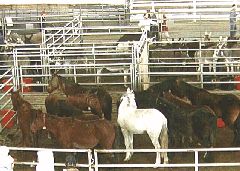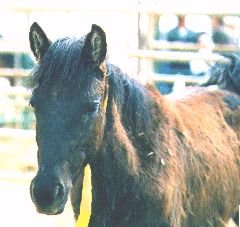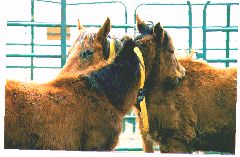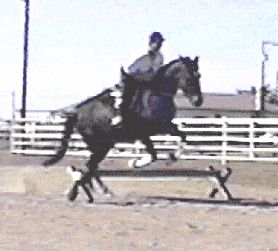|
|
|
ARE YOU CONSIDERING ADOPTING A WILD HORSE?
|

From The Wild Horse: An Adoptor's Manual
By Barbara Eustis-Cross and and Nancy Bowker
edited for this website and additional comments added by Willis Lamm
 Congratulations on your interest in adopting one of America's wild horses! Across the country owners of wild horses are discovering the true value of these intelligent, hard working and sure-footed animals. Congratulations on your interest in adopting one of America's wild horses! Across the country owners of wild horses are discovering the true value of these intelligent, hard working and sure-footed animals.
We sincerely hope that anyone who wishes to adopt a wild horse is looking
for a friend and companion and not a yard ornament. Some people who decide
they want a wild horse think they are saving it from death or slaughter. The
wild horses which are protected by The Wild Horse and Burro Act, and are cared
for by the Bureau of Land Management, are not sold for slaughter or killed.
Some people who want a wild horse do not intend to use the horse; instead they
want to turn him out to pasture to live out his days. Unfortunately, this
seldom works to the horse's benefit. Wild horses are herd animals that depend
on other members of the band or herd for their physical and mental well being.
Without this interaction with his own species or a substitute, such as a human
companion, the wild horse becomes a ghost of his true self.
Additional problems arise if the wild horse becomes ill or if basic "hands-on"
animal care is required. If not properly gentled, such items of husbandry as hoof trimming, cannot be safely done. These horses are frightened of new people, places, and things and when pressured they will act "wild." Yet the wild
horse and the domestic horse are alike in many ways. Both fear the unknown
and will react by trying to run or escape from something that frightens them.
In the wild horse this instinct to flee is more highly developed than it is in
most domestic horses.
There will be much to think about before you decide to adopt; special
preparations to be made before you bring your horse home and precautions to
consider that will prevent injury to yourself and your horse during the
gentling process.
Although only one member of the family may be adopting a wild horse, everyone
will be affected by the decision. The hours necessary to gentle and train a
wild horse may put additional pressures or responsibilities on other family
members. Even if the horse is not being adopted for family use, Make sure the
other members of your family are willing to support your decision in adopting
a wild horse.
You may be able to approach, touch and ride a trained domestic horse
immediately, but a wild horse will require time to adjust to everything from
feed and housing to trusting human beings. Your expectations as to how soon
you will be getting started handling and training your new adoptee should be
realistic and be based on the horse's needs, not your own ambitions. During
this time, a little patience and the pursuit of some knowledge about basic
horse behavior will likely pay big dividends in the long run.
Many factors will determine how long it will take before your wild horse can
be ridden. In general, a domestic horse is ready to carry a rider on his back
when he is about 2½ years old. Most gentle domestic horses will receive 30 to
60 days training to reach the "green broke" stage. At this stage a horse
knows the basic commands, signals, and cues and is comfortable with a quiet,
competent rider on his back. (It should be noted, however, that high impact
work should be avoided at this age since the growth plates in a young horse's
joints are not yet fully formed.)
With your adoptee, his age at the time of adoption is but one item which will
have to be considered. Particularly if coming from poor range, it may take as
long as long as six months for your horse to be physically fit before you can
begin actual training. In addition, before the horse bears the weight of a
rider he should have been appropriately trimmed or shod for sufficient time
that his stride and foot flight are correct and his tendons have adjusted to
the dynamics of human farriery.
While mounting your adoptee may be some time off, ground work and the
gentling of your wild horse should start right away. Here again, an
understanding of how a horse behaves and how he decides whom is his social
superior and social subordinate has a significant impact on how readily and comfortably he accepts your control. The wild horse has grown up in the equine social order and if you appear to him as a competent leader by his standards, he will be comfortable following you.
Aggressive behavior and / or overreaction by humans do not register high marks
on the horse's "competent leader" scale. Overembellishment with goodies,
while perhaps a positive distraction when the horse is first getting adjusted,
does nothing to establish the human as a qualified superior. In fact, you may
find it even more difficult to become recognized as the herd leader when you
have spent your entire introductory period "advertising" yourself as a walking
goodie wagon.
 Thoughtful grooming is a courtesy and reward exchanged between horses. It is
a social behavior which, when done correctly, is instinctively appreciated.
Scratches and strokes are easy rewards you can provide for good behavior.
Hard "pats" should be avoided as such sudden contacts, which might be regarded
as playful by your dog, are generally considered as aggressive or negative
advances by horses. Thoughtful grooming is a courtesy and reward exchanged between horses. It is
a social behavior which, when done correctly, is instinctively appreciated.
Scratches and strokes are easy rewards you can provide for good behavior.
Hard "pats" should be avoided as such sudden contacts, which might be regarded
as playful by your dog, are generally considered as aggressive or negative
advances by horses.
You should respect your horse's space and he should respect yours. A
competent leader does not make sudden moves or loud noises that would upset
his herdmates unless danger was eminent and flight was required or he intended
to discipline his subordinates. A competent herd leader is watchful and looks
out for the safety and well being of everyone (and every horse).
 If you set yourself up in the horse's mind as a leader, it is his instinct to
follow. When you get this pattern working for you, those things which would
ordinarily be difficult can become easy.
If you set yourself up in the horse's mind as a leader, it is his instinct to
follow. When you get this pattern working for you, those things which would
ordinarily be difficult can become easy.
(Or as one adopter recently posted on the "wildhorses" list server, "Money can't buy happiness, but 125 dollars will get you sheer joy!")
The Wild Horse, and Adopter's Manual is no longer in print.
If another edition is released, we will post information about it in the
Wild Horse Store.
Adapted for this site with permission from Barbara Eustis-Cross
Webmaster's Note: It's not the purpose of this site to promote anyone's books or products,
however Barbara and Nancy have provided a ton of good material in this book.
In addition to information which is "wild horse specific," they have provided
a great deal of information on general horse care, feeding, veterinary considerations,
practical anatomy, horse behavior, housing, basic training, bitting and saddling, first aid, etc.
Thus I would offer that this work is valuable to anyone who is contemplating for the first
time the bringing up of young horses, building practical animal housing, undertaking basic
training, and so forth. In spite of its stereotypical title, it is useful to more than
just those who are interested in acquiring a BLM wild horse.
This is not a BLM operated or BLM sponsored site. It
is run by private wild horse and burro enthusiasts. We are thankful to the
BLM for providing the information which is presented here.

|